Crustacea
.
Together with the insects, the crustaceans are the most important freshwater
representatives of the Arthropoda or jointed-legged animals. (The Hydracharina
or water mites, which resemble tiny spiders, are also diverse but extremely
poorly known in Asia.) The insects have three body parts (head, thorax
and abdomen) and six legs; the adults are winged. Crustacean bodies are
usually divided into two parts, and have more than six legs plus appendages
on the abdomen. The most conspicuous crustaceans in tropical Asian rivers
are members of the order Decapoda: the shrimps, crabs and crayfishes.
The rest consists of small crustaceans from a variety of orders; some
are major constituents of the zooplankton and a few others are habitat
specialists or parasites of fishes. Crustaceans have varied reproductive
habits. Some species carry their eggs until they hatch into (in certain
cases) a minute replica of the adult. Others have complex life cycles
with one or more larval stages that differ from the adult in appearance
and, sometimes, in habits.
Small crustaceans
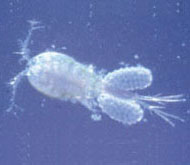 Small
crustaceans are especially important in standing fresh waters, where they
form a link between microorganisms and algae, on which they feed, and
fish, which feed on them. Tiny species of the order Ostracoda and harpacticoid
and cyclopoid copepods occur in flowing waters where (together with rotifers
and nematodes) they make up the interstitial fauna inhabiting the spaces
between particles of sand and mud in river beds. Other copepods and members
of the order Cladocera constitute the majority of zooplankton, although
rotifers and protozoans may be present also (see Fernando 1980, for details).
Small
crustaceans are especially important in standing fresh waters, where they
form a link between microorganisms and algae, on which they feed, and
fish, which feed on them. Tiny species of the order Ostracoda and harpacticoid
and cyclopoid copepods occur in flowing waters where (together with rotifers
and nematodes) they make up the interstitial fauna inhabiting the spaces
between particles of sand and mud in river beds. Other copepods and members
of the order Cladocera constitute the majority of zooplankton, although
rotifers and protozoans may be present also (see Fernando 1980, for details).
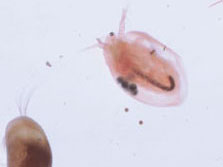 Flowing
water is a poor habitat for zooplankton, unless phytoplankton is present
also, and they are largely confined to large rivers and floodplain pools
and backwaters. Crustacean zooplankton have an advantage over phytoplankton
because they are able to swim and may make vertical and lateral movements
in the water column; these can lead to diurnal fluctuations in night-time
peaks in zooplankton abundance at the water surface. Seasonal changes
in abundance are apparent also, and match those seen in phytoplankton
with peaks in the dry season and declines during monsoonal floods. Anostracans
(Fairy shrimps) can occur in dense swarms in floodplain pools and channels.
Their eggs (and those of some crustacean zooplankton) are deposited in
the bottom mud where they remain dormant, even withstand desiccation,
during the dry season. Upon inundation by rising river levels or rainfall,
the eggs produce hatchlings that develop quickly to complete their life
cycle. The resistant egg stage accounts for the ability of isolated water
bodies on the floodplain to support dense populations of Anostraca and
zooplankton soon after they have filled with water.
Flowing
water is a poor habitat for zooplankton, unless phytoplankton is present
also, and they are largely confined to large rivers and floodplain pools
and backwaters. Crustacean zooplankton have an advantage over phytoplankton
because they are able to swim and may make vertical and lateral movements
in the water column; these can lead to diurnal fluctuations in night-time
peaks in zooplankton abundance at the water surface. Seasonal changes
in abundance are apparent also, and match those seen in phytoplankton
with peaks in the dry season and declines during monsoonal floods. Anostracans
(Fairy shrimps) can occur in dense swarms in floodplain pools and channels.
Their eggs (and those of some crustacean zooplankton) are deposited in
the bottom mud where they remain dormant, even withstand desiccation,
during the dry season. Upon inundation by rising river levels or rainfall,
the eggs produce hatchlings that develop quickly to complete their life
cycle. The resistant egg stage accounts for the ability of isolated water
bodies on the floodplain to support dense populations of Anostraca and
zooplankton soon after they have filled with water.
Large crustaceans
The majority of the larger crustacean species belongs to the order Decapoda.
It contains approximately 1,000 freshwater species – most of them
tropical. Although the body form can vary, all decapods have five pairs
of legs, of which the first (in crabs) and often the second (in shrimps
and prawns) end in chelae or 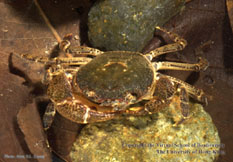 'pincers'.
The freshwater shrimps and prawns are comprises almost entirely of the
family Atyidae (which are virtually all freshwater forms) and the family
Palaemonidae (which has some species that require brackish conditions
for part of their lives).
'pincers'.
The freshwater shrimps and prawns are comprises almost entirely of the
family Atyidae (which are virtually all freshwater forms) and the family
Palaemonidae (which has some species that require brackish conditions
for part of their lives).
The largest and most widespread atyid genus is Caridina, and these
small (< 3 cm long) shrimps are important consumers of fine organic
material in small and large rivers. They collect food with their bristle-covered
chelae, using them to brush the substratum or expanded into a 'fan' that
sifts the passing water current. Atyopsis is larger than Caridina,
but has broadly similar habits. Macrobrachium is by far the most
important and species-rich genus of Palaemonidae, and is easy to recognise
because the appendages with the second pair of pincers are greatly enlarged
and much longer than the first. Macrobrachium has a broad diet,
but individuals tend to be more carnivorous as they grow. Members of this
large genus differ greatly in body size and habitat use. Some species
are confined to hillstreams; other, usually larger, species live in the
lower course of large rivers. Some of these larger 'prawns' may be important
in local fisheries, and Macrobrachium rosenbergii (which can exceed
20 cm in length) is a significant aquaculture species. In Macrobrachium
species that live in large rivers, the wet season is associated with breeding
and migrations onto inundated floodplains where food availability is high
and there is more habitat available for juveniles.
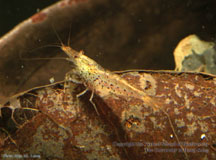 |
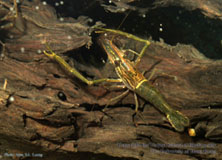 |
Freshwater crabs are distinctive elements of stream faunas in tropical latitudes, and we have only recently begun to appreciate their great diversity in Asia. True freshwater crabs spend their entire lives in streams and rivers, but there is also a number of estuarine or mangrove crabs in the family Grapsidae that may move into entirely fresh water spending some or almost all of their lives in rivers. Six families of crabs – arranged in two superfamilies (the Potamoidea and Gecarcinucoidea) – can be considered true freshwater crabs, but some of them have evolved a tendency towards and amphibious life style. Sinopotamids (and grapsids) are entirely aquatic and feed in water, potamids and parathelphusids are amphibious and feed in water and on land, while isolapotamids have become largely terrestrial and feed on land much of the time. The details of diet and habitat use vary considerably among species. Most eat plant material (which may be supplemented by carrion or live prey but some inhabit only forested upland streams while others live in lowland rivers.